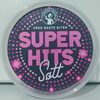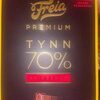E163 - Antocyaniner
Funksjoner: Farge
Anthocyanins -also anthocyans; from Greek: ἄνθος -anthos- "flower" and κυάνεος/κυανοῦς kyaneos/kyanous "dark blue"- are water-soluble vacuolar pigments that, depending on their pH, may appear red, purple, or blue. Food plants rich in anthocyanins include the blueberry, raspberry, black rice, and black soybean, among many others that are red, blue, purple, or black. Some of the colors of autumn leaves are derived from anthocyanins.Anthocyanins belong to a parent class of molecules called flavonoids synthesized via the phenylpropanoid pathway. They occur in all tissues of higher plants, including leaves, stems, roots, flowers, and fruits. Anthocyanins are derived from anthocyanidins by adding sugars. They are odorless and moderately astringent. Although approved to color foods and beverages in the European Union, anthocyanins are not approved for use as a food additive because they have not been verified as safe when used as food or supplement ingredients. There is no conclusive evidence anthocyanins have any effect on human biology or diseases. - Wikipedia
EFSA-evaluering: Scientific Opinion on the re-evaluation of anthocyanins -E 163- as a food additive (2013-04-23)
Land: Norge - Se samsvarende produkter fra hele verden
-
Pacific Punch - Monster Energy - 500 ml

-
Raspberry duo biscuit - Coop - 175g

-
Superhits Søtt - Candy People - 250g

-
Doc' Halslinser Bringebær & sitron - Nidar - 50g
-
Premium Tynn 70% Bringebær - Freia - 100g

-
Søtbakst Donuts med gul glasut - Mesterbakeren - 134g

-
japan - Sunrise
-
Mochi - The food court - 6 pieces, 210 g

-
Snap and Crackle - Swizzels - 18g

-
Mega Stix - Sweetzone - 200g

-
Julebrus - PetPack Drikker - 1,5L

-
Sour Chewy Candies - Brain Blasterz - 60 g

-
Mentos Rainbow - 37,5g

-
Sjokolade Smågodt - Minde - 180g

-
Monster Energy Ultra Black - 500ml

-
Nidar Troika - 66 g

-
Monstee ultra fiesta mango - Monster Energy - 500ml

-
Pasjonsfrukt - Solo - 1.5 L

-
Juicy Foams - Jealous Sweets - 125 g

-
Jealous Sweets - 125 g

-
Kids Party Mix - Coop - 180g

-
Yummy Gummi Søt Fruktsmak - Snop! - 250g

-
Knall Godt

-
Lollipop Bites - Diplom-Is - 80g

-
Lollipop Sour Bites - Diplom-Is - 80g

-
Potetgull Brunet smør & Chili - Maarud - 200g

-
Friskis - Hennig Olsen - 86 g

-
Liquorice Allsorts - Bassetts - ℮ 190g

-
Knatter - Brynild - 80 g

-
Sukkerfri Julebrus - PetPack Drikker - 1,5L

-
Nidar Favoritter - 300g

-
Julebrus - Unil - 6 x 330 ml

-
Julebrus - Unil - 0,33L

-
Solo Super Rød Julebrus - 0,33L

-
Super Solo Rød Julebrus - 6 x 0,33L

-
Solo Super Rød Julebrus - 0,5L

-
Rudolf & Nissens Julebrus uten sukker - Oskar Sylte - 0,33L

-
Rudolf & Nissens Julebrus uten sukker - Oskar Sylte - 6 x 0,33L

-
Supermix Orginal - Brynild

-
Rudolf & Nissen Julebrus - Oskar Sylte - 6 x 0,33L

-
Rudolf & Nissen Julebrus - Oskar Sylte - 0,33L

-
Oskars Sylte Annanassmak - Oskar Sylte - 1,5L

-
Rudolf & Nissens julebrus - Oskar Sylte - 1,5L

-
Sukrede Skumjordbær - Sunrise - 175g

-
Monster Juiced Khaotic - 500ml

-
Raw Energy Raspberry & Blueberry - Rubicon - 500ml

-
Dipperz - bazooka - 12g

-
Julebrus - Grans - 1,5L

-
Nidar Favoritter - 183g
